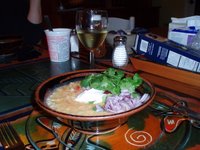



 Second: borscht, which tasted just like my mother's but included dumplings.
Second: borscht, which tasted just like my mother's but included dumplings. Third: stuffed salmon with vegetables.
Third: stuffed salmon with vegetables.


 Miriam eats:
Miriam eats:



 In today's Guardian online is an article about Christmas Dinner: evidently an English Christmas dinner: "Top chefs' tips for Christmas -- How do you keep turkey moist? Can sprouts be interesting? We ask British chefs for their festive secrets."
In today's Guardian online is an article about Christmas Dinner: evidently an English Christmas dinner: "Top chefs' tips for Christmas -- How do you keep turkey moist? Can sprouts be interesting? We ask British chefs for their festive secrets."Brown sugars now come in a range of flavors: Demerara, turbinado and raw sugars are like the “first pressing” of the sugar: they are first to rise to the top during processing and have the lightest molasses flavor. Muscovado, a loamy, crumbly dark brown sugar, has the most. Most commercial brown sugars are not naturally brown from cane solids, but are a late-stage mixture of refined white sugar and molasses.This confirms what I've heard in the past: that various brown sugars occurred during the refining process. When sugar refining was done on a smaller scale, for various reasons the less-fully-refined sugars were used, though less valued. Eventually sugar refining became totally industrial, and suddenly the brown sugars, once considered crude, became valued for the greater variety of flavors. And a new process was invented to produce these versions in a consistent, efficient way. Like bitter greens and potatoes, a food of poor rural people is elevated to a different status.

 In summer, I had to go back to the library really often. When you checked out a book you could keep it for around two weeks, but I would get four books and start reading as soon as I got home. Once I got three Nancy Drew mysteries, and read them all in one afternoon, so I had to go back the very next day. In summer I went to the library every few days. In winter when I had school work, the books might last me the whole two weeks.
In summer, I had to go back to the library really often. When you checked out a book you could keep it for around two weeks, but I would get four books and start reading as soon as I got home. Once I got three Nancy Drew mysteries, and read them all in one afternoon, so I had to go back the very next day. In summer I went to the library every few days. In winter when I had school work, the books might last me the whole two weeks. Magical things happened in Oz, and the characters were usually lucky and guessed what they had to do. Once there was a very bad man, and Dorothy (or another character) realized that if she threw an egg at him, he couldn't do bad things any more. It was similar to how Dorothy threw water on the Wicked Witch, or had her house land on the other Witch. Dorothy always came out ok.
Magical things happened in Oz, and the characters were usually lucky and guessed what they had to do. Once there was a very bad man, and Dorothy (or another character) realized that if she threw an egg at him, he couldn't do bad things any more. It was similar to how Dorothy threw water on the Wicked Witch, or had her house land on the other Witch. Dorothy always came out ok. A German tradition for the holidays is Nürnberger Lebkuchen.
A German tradition for the holidays is Nürnberger Lebkuchen. Harold McGee is author of On Food and Cooking and other wonderful books about what happens when you cook. He explains the inner workings of mayonnaise, rising dough, foaming egg whites, and answers almost every cooking-chemistry question you can think of. It's a wonderful reference book to have at hand. I've enjoyed it for years.
Harold McGee is author of On Food and Cooking and other wonderful books about what happens when you cook. He explains the inner workings of mayonnaise, rising dough, foaming egg whites, and answers almost every cooking-chemistry question you can think of. It's a wonderful reference book to have at hand. I've enjoyed it for years. This made me realize: in my own shopping, I buy canned tomatoes, corn, tuna, beans, and soup. But always fresh greens and fresh fruit. Giving my preferred canned goods to a food drive is insensitive to the needs of the needy. I can buy fresh produce because I'm lucky to have enough time, enough money, and a kitchen where I can keep things fresh. I'm a little embarrassed because for the pre-Thanksgiving food drives, I specifically bought what I thought was good-quality canned soup. But of course it's a starchy product, and now I know better.
This made me realize: in my own shopping, I buy canned tomatoes, corn, tuna, beans, and soup. But always fresh greens and fresh fruit. Giving my preferred canned goods to a food drive is insensitive to the needs of the needy. I can buy fresh produce because I'm lucky to have enough time, enough money, and a kitchen where I can keep things fresh. I'm a little embarrassed because for the pre-Thanksgiving food drives, I specifically bought what I thought was good-quality canned soup. But of course it's a starchy product, and now I know better.

 Roasted potatoes can be a Thanksgiving dish, which this year, they were. They are good with any roast, though. At some grocery stores "fingerling" potatoes have been available recently. Arny bought the ones for our Thanksgiving dinner at Costco. A week earlier, I bought some at Whole Foods in Ann Arbor. If the fingerling fad doesn't last, I'll go back to making them with smallish redskins or Yukon Golds.
Roasted potatoes can be a Thanksgiving dish, which this year, they were. They are good with any roast, though. At some grocery stores "fingerling" potatoes have been available recently. Arny bought the ones for our Thanksgiving dinner at Costco. A week earlier, I bought some at Whole Foods in Ann Arbor. If the fingerling fad doesn't last, I'll go back to making them with smallish redskins or Yukon Golds.

 The quantity above serves 2 to 3 people. For 6 people, I made a triple batch. You can vary the amount and type of fruit to your taste, you can add sugar, and you can vary the whole-grain component to change the texture.
The quantity above serves 2 to 3 people. For 6 people, I made a triple batch. You can vary the amount and type of fruit to your taste, you can add sugar, and you can vary the whole-grain component to change the texture. All over the Americas, the Indians grew pumpkins and gourds, and everyone knows that they introduced the early European immigrants to the New World squash family. This photo is from the Farmer's Market in Los Alamos, NM in 2004.
All over the Americas, the Indians grew pumpkins and gourds, and everyone knows that they introduced the early European immigrants to the New World squash family. This photo is from the Farmer's Market in Los Alamos, NM in 2004. At Erin's request, here is some information on how I make cauliflower soup.
At Erin's request, here is some information on how I make cauliflower soup. To serve, reheat and garnish hot soup with any or all of the garnishes. Or let diners garnish their own soup. You can also serve this soup cold with sour cream and green herbs.
To serve, reheat and garnish hot soup with any or all of the garnishes. Or let diners garnish their own soup. You can also serve this soup cold with sour cream and green herbs."Leafy vegetables are the second leading source of E. coli infections in the United States, behind ground beef, but the government relies primarily on voluntary safety steps by farmers and packagers to prevent outbreaks.Also, yesterday I read an important explanation of how this could happen, reported in the New York Times. I have been wondering how spinach bags could be contaminated. Here is the crucial statement attributed to an expert in the field:"The cleanliness of fresh produce is drawing new attention amid reports that tainted spinach has been found recently in 21 states, killing at least one person and sickening more than 100 others. A second death was under investigation.
"Some consumer groups believe the government should do more to regulate farming and packaging, including the quality of water used for irrigation, the application of manure and sanitary facilities used by workers." -- AP story: "Tainted spinach sparks calls for more food safety oversight." Posted on CNN: 12:10 p.m. EDT, September 19, 2006
"The cause of the outbreak is still not clear. It could be irrigation water ... or it could be a processing problem in a factory. In the humid environment of a sealed bag of spinach or salad mix, E. coli can multiply rapidly if the bag is allowed to get too warm... . Some processors expose spinach to chlorine to kill E. coli, which can kill the bacteria on the leaf surface. But if the bacteria are in irrigation water they can enter the plant, and the chlorine will not reach them... ." from Agency Says It Can't Order Spinach Recall by MATTHEW L. WALD and MARIA NEWMAN
One more Addendum, Sept. 20
Here is one more word from the same expert, Dr. David Acheson, in today's New York Times. Evidently, slow and local is getting some recognition:
"Dr. David Acheson, chief medical officer of the Center for Food Safety and Applied Nutrition at the F.D.A., said the agency “wants to maintain a simple consumer message’’ and not confuse people by saying which circumstances are appropriate for eating uncooked spinach. But in a telephone conversation he acknowledged that it is less risky to eat locally grown spinach.
"'Clearly the risk is significantly reduced if you know the farmer and know his farm,' he said, 'particularly if you are on the East Coast,’ far from the suspected source of the contamination." -- From the brief article "A Stopgap for the Spinach Lover"
WOW, here in the midwest we aren't far enough from California to be safe from the scourge. Those E.coli must really be powerful.
 everyone knows the burgers and fries are high in all fat, especially in bad fat; low in fiber and vitamins; and made in a way that's bad for the global environment. Everyone knows the bad side of soft drinks. Good side of American hamburger chains: clean public rest rooms. Don't forget the original good side: when you go to a chain fast-food place anywhere in the world, you know exactly what you will get.
everyone knows the burgers and fries are high in all fat, especially in bad fat; low in fiber and vitamins; and made in a way that's bad for the global environment. Everyone knows the bad side of soft drinks. Good side of American hamburger chains: clean public rest rooms. Don't forget the original good side: when you go to a chain fast-food place anywhere in the world, you know exactly what you will get.
 Who knows?
Who knows? In my story blog, I just wrote about farmers' markets: Farmers' Markets. In an earlier post on this blog: Very Interesting Articles on Food, I referred to The Omnivore's Dilemma, in which Michael Pollan discusses the issues of slow and fast food in our society.
In my story blog, I just wrote about farmers' markets: Farmers' Markets. In an earlier post on this blog: Very Interesting Articles on Food, I referred to The Omnivore's Dilemma, in which Michael Pollan discusses the issues of slow and fast food in our society. While I'm pretty turned off at some of the Nation's politics these days, I found a really wonderful set of articles on food in the current issue. Especially interesting: One Thing to Do About Food: A Forum. The editor of this set of short pieces is Alice Waters. Contributors: Eric Schlosser, Marion Nestle, Michael Pollan, Wendell Berry, Troy Duster, Elizabeth Ransom, Winona LaDuke, Peter Singer, Dr. Vandana Shiva, Carlo Petrini, Eliot Coleman, and Jim Hightower.
While I'm pretty turned off at some of the Nation's politics these days, I found a really wonderful set of articles on food in the current issue. Especially interesting: One Thing to Do About Food: A Forum. The editor of this set of short pieces is Alice Waters. Contributors: Eric Schlosser, Marion Nestle, Michael Pollan, Wendell Berry, Troy Duster, Elizabeth Ransom, Winona LaDuke, Peter Singer, Dr. Vandana Shiva, Carlo Petrini, Eliot Coleman, and Jim Hightower.All the writers, I would say, agree with Eric Schlosser's statement: "Once you learn how our modern industrial food system has transformed what most Americans eat, you become highly motivated to eat something else."
At one time, I would have considered the following extreme, but now I don't: "Food is destiny, all right; every decision we make about food has personal and global repercussions. By now it is generally conceded that the food we eat could actually be making us sick, but we still haven't acknowledged the full consequences--environmental, political, cultural, social and ethical--of our national diet." So writes Alice Waters in her piece called Slow Food Nation.
And from a more global perspective: "Humanity has eaten more than 80,000 plant species through its evolution. More than 3,000 have been used consistently. However, we now rely on just eight crops to provide 75 percent of the world's food. With genetic engineering, production has narrowed to three crops: corn, soya, canola. Monocultures are destroying biodiversity, our health and the quality and diversity of food." So writes Dr. Vandana Shiva in the Forum.
All this has great resonance with The Omnivore's Dilemma by Michael Pollan, who is also a contributor to the Nation's Forum. Pollan's book provides meticulous detail about where our food comes from: a strictly artisan's organic meal, a Whole Foods more mass produced organic meal, and a mainstream meal from MacD's. The Nation article on the unfortunate labor practices of big organic farms in California adds another dimension to what I learned from Pollan. (See Felicia Mello's article titled Hard Labor.)
Several other articles on the global food situation are also worth reading, including one by Frances Moore Lappé. So check out this week's issue of